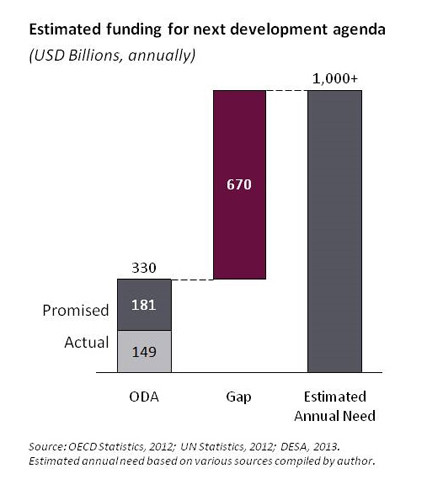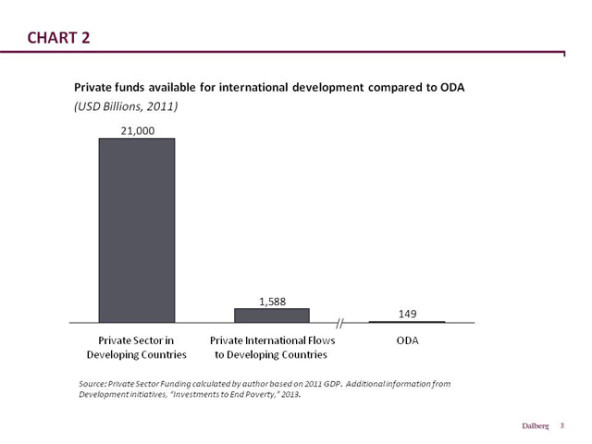Imagine you have the opportunity to define how the world develops for the next 15 years. All government projects, nonprofit work, and foundation funding would cater to your agenda. If you are one of the representatives of the 193 United Nations member states currently discussing the new global agenda, your job entails exactly that.
By 2015, when the current development agenda expires, the international community must determine a new set of goals, and how to achieve and fund them. Based on early recommendations from the UN Secretary General’s office, this next-generation agenda will probably be more ambitious in scope and cost than the present Millennium Development Goals (MDGs). While the current MDGs focus on a narrowly defined set of eight goals, the new global agenda will likely aim to both end poverty and increase sustainable development across many dimensions.
 Relying on aid to fund the next development agenda will leave a gap of over 600 billion dollars, even if aid levels increase.
Relying on aid to fund the next development agenda will leave a gap of over 600 billion dollars, even if aid levels increase.
The proposed new, more ambitious agenda—depending on its scope—will cost approximately $1 trillion annually. This far exceeds current international aid, or overseas development assistance (ODA), which typically hovers around $150 billion per year. Even if aid rises to the levels that rich countries pledged they would give per several international agreements—0.7 percent of developed countries’ gross national income (GNI)—aid would add up to only about $330 billion annually. Relying purely on current funding channels has proven insufficient (see chart). Rich country government assistance lags far behind the needs of poor and middle-income countries. Even with increased private-sector spending to these countries, funding will not flow to the right areas; the goal of private sector investments is not to reduce poverty and increase development. Left alone, the amount of funding reaching the new development agenda will leave a significant gap; thus, we must look for new, unconventional channels to finance the next round of development funding. As leaders across sectors convene to discuss the new agenda they have a clear opportunity to collaborate on a new breed of large-scale development projects.
Unlocking More Money Through Innovative Financing
Development projects known as “innovative financing” reflect a new way of filling this funding gap. The term, coined in 2002 at a UN conference, refers to projects that raise money for development in new ways and spend money more effectively. Given a variety of creative names, in truth innovative financing programs take just three different forms: pay only for results, make funding of the development agenda a safer investment, and find new funders. Variations of innovative financing programs include known mechanisms such as social impact bonds or pay-for-success programs, which are used more and more frequently—research by Dalberg suggests at least a half dozen new initiatives have launched annually, on average, since 2002. To date, these programs have been initiated independently and for an array of causes on an ad-hoc basis.
Are you enjoying this article? Read more like this, plus SSIR's full archive of content, when you subscribe.
Development leaders now have the opportunity to apply innovative finance tools on a major scale and in a systematic way; they also have new information on where and how to apply them. The most promising element of innovative financing is its ability to unlock pools of funds from the private sector, which typically finds development projects too risky and the results too uncertain to warrant investment. Funders of these development programs do not need to be impact investors looking for social returns; instead, programs can generate high returns or reduce risk for traditional investors. Innovative financing can also tap into additional public funds by providing opportunities for global coordination and public-private partnerships.
Pay only for results
Spending money more effectively by paying for results rather than promises has two benefits: It reduces the total size of the fund needed to achieve the next-generation agenda and also ensures a greater impact from every dollar spent. For example, when the development community learned that Western pharmaceuticals were holding back from developing a cheap pneumonia vaccine for Africa because of a legitimate fear that there would be no money to buy these vaccines after they invested in building capacity, they designed an innovative financing program. The resulting program, known as the Pneumococcal Advance Market Commitment, guaranteed a minimum market size to any pharmaceutical company that could develop an appropriate vaccine. This enabled Pfizer and others to scale facilities that have since vaccinated more than 10 million children; it also enabled them to sell vaccines at less than 10 percent of their usual cost. Another results-based innovative financing mechanism, the Haiti Mobile Money prize, rewarded mobile operators in Haiti with $6 million to build out mobile banking. If applied to initiatives in the next development agenda, such cost-effective programs would reduce the total dollars needed.
Make funding development safe
Innovative financing mechanisms include a whole suite of creative funding vehicles that shift risk away from funders, making development projects a safer investment. This includes social impact bonds and insurance for funders, who can then invest in projects that would otherwise be too risky—for example, global health clinics, rural energy, and agriculture equipment. The recently launched HUGinsure provides up to $400 million in insurance backed by Lloyd’s, making it safe for private sector banks to fund unproven social impact projects. A potential new malaria bond will draw on public-private funders who will pay program implementers only if malaria eradication is successful. Such social impact bonds allow third-party backers like governments to take on risk instead of the private sector funder. Without these mechanisms, private funders tend to invest in sectors such as natural resource extraction, which offer immediate returns. But with them, private funders can benefit from sectors with more diffuse value, such as health and infrastructure.
Find new funders
Innovative mechanisms for raising new funds broaden the funding toolkit beyond simple grants and equity. Such mechanisms include ongoing programs such as social taxes and voluntary solidarity contributions, which raise small amounts of funds over time. A solidarity tax on airline tickets in France, for example, charges travelers a few dollars each time they leave French soil, and has raised nearly $2 billion since 2006 for the global health initiative UNITAID. This can also include large programs such as carbon emissions trading, which has raised more than $30 billion since 2002.
The Private Sector Potential
Compared to international aid—which represents less than 1 percent of available funding for development—harnessing private sector funding presents a significant new opportunity for backing the new development agenda. Private sector spending within and flowing to low- and middle-income countries represents a rapidly growing pool –more than $20 trillion (see chart). Tapping into even a small portion of that through innovative financing would draw immense new resources. And more effectively allocating this funding means fewer dollars will be needed.
 Private sector funds available for international development represent a pool more than one hundred times larger than aid dollars.
Private sector funds available for international development represent a pool more than one hundred times larger than aid dollars.
Innovative financing has been limited in size because setting up global mechanisms requires convening major decision-makers and alignment around agenda items. In the past, innovative financing mechanisms have raised only about $1 billion to $3 billion in new funds annually. But as heads of state, foundation CEOs, and international development leaders come together to discuss development priorities over the next year, the development community has a unique opportunity to set up new innovative financing mechanisms on a much bigger scale.
Though this funding would bridge only a small portion of the $1 trillion required for the next-generation development agenda, without it, many areas with benefits beyond financial returns will remain underfunded—private sector investors will continue to fund only clearly profitable projects such as mining. With increased coordination and fresh lessons from past experiments, development leaders can effectively wield innovative financing for greater impact.
Support SSIR’s coverage of cross-sector solutions to global challenges.
Help us further the reach of innovative ideas. Donate today.
Read more stories by Angela Rastegar Campbell.

